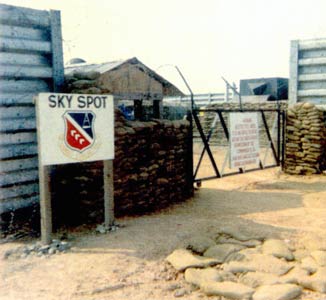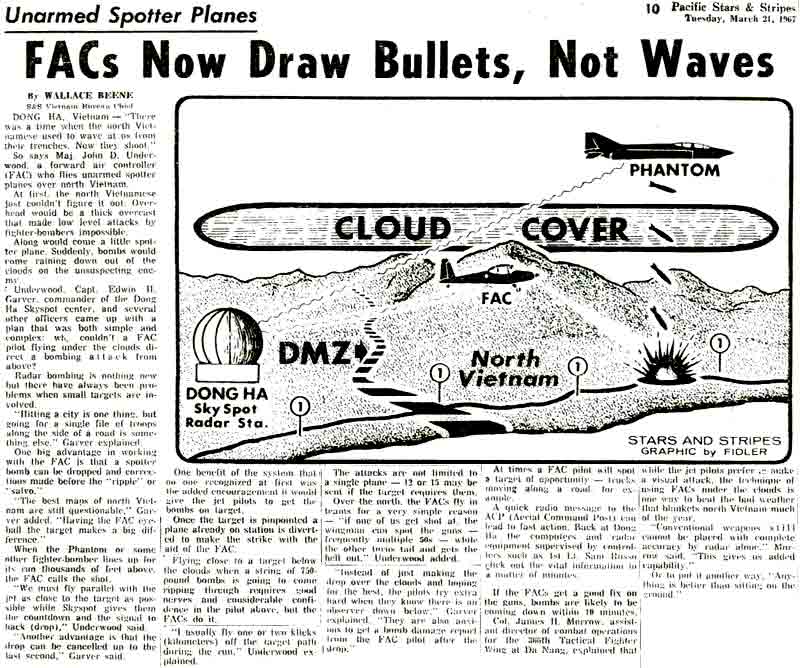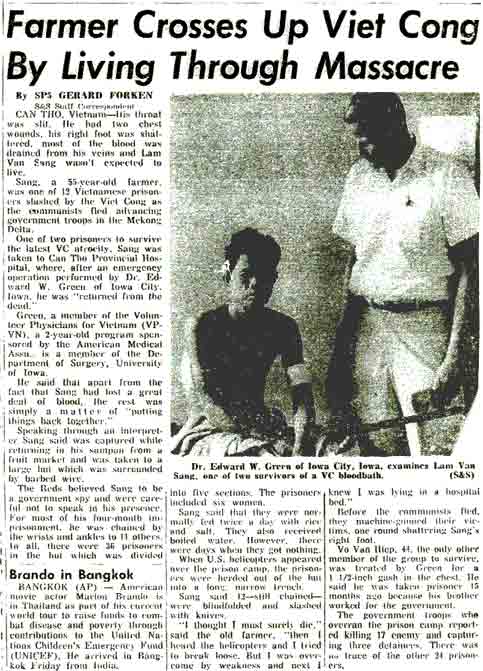Sky Spot 1967 and the "Pacific
Stars and Stripes" Story SNAFU
 Sky
Spot Radar Stations were responsible for coordinating and directing
B-52 Arc Light missions and fighter-bomber sorties against the North
Vietnamese Army and Viet Cong units within a 200 mile radius of each
radar station. One of those sites was located at the Korat RTAFB
that was the northern most Air Force site in Vietnam. At only 6 miles
south of the DMZ, Đông Hà Air Field was in a critical and needless to say very
vulnerable location.
Sky
Spot Radar Stations were responsible for coordinating and directing
B-52 Arc Light missions and fighter-bomber sorties against the North
Vietnamese Army and Viet Cong units within a 200 mile radius of each
radar station. One of those sites was located at the Korat RTAFB
that was the northern most Air Force site in Vietnam. At only 6 miles
south of the DMZ, Đông Hà Air Field was in a critical and needless to say very
vulnerable location.
The North Vietnamese Army was heavily concentrated
in the area with two divisions of troops supported by 140mm and 122mm
rocket regiments, 130mm and 152mm artillery regiments, AAA and Surface
to Air Missile (SAM SA-2) sites. All tolled the NVA had over 100 artillery
guns dug into the DMZ. The main objective of the NVA was to over run
Quang Tri Province. The Marines and NVA fought a series of very bloody
battles within and just south of the DMZ starting in the spring of
1967. The Marines, along with some timely and massive B-52 and fighter-bomber
air support, blocked the NVA from their objective.
The B-52s, directed by Sky Spot, bombed areas of
NVA supplies and troop concentrations. More importantly to the Air
Force personnel at the Korat RTAFB, the B-52's pounded with big
bunker buster bombs the dug in, heavily camouflaged NVA 130mm and
152mm artillery positions in the DMZ which were pounding the Đông Hà Air Field area and other Marine bases at will. The B-52's hit the NVA positions
both day and night. At Đông Hà Air Field the earth would shake from the impact
of the bombs and at night the flashes from the B-52 strikes would
ripple in the distance. Although the B-52 strikes raised havoc with
the two divisions of NVA troops, the artillery, AAA and SAM sites
weathered the bombing and remained just as deadly as ever.
In the Tuesday, March 21, 1967 edition of the Pacific
Stars and Stripes, there appeared an article titled "FAC's
Now Draw Bullets, Not Waves." The article went into some detail
explaining that the weather conditions such as "thick overcast
made low level bombing by fighter-bombers impossible." It detailed
the FAC's (Forward Air Controller) role in the bombing mission and
also gave some insight into the Sky Spot operations at the Đông Hà Air Field
Air Base. The article explained that, "…a FAC pilot will
spot a target of opportunity - trucks moving along a road for example.
A quick radio message to the Aerial Command Post can lead to fast
action. Back at Đông Hà Air Field the computers and radar equipment…click
out vital information in a matter of minutes. Once the target is pinpointed,
a plane already on station is diverted to make the strike with the
aid of the FAC."
There was a drawing with the article showing the
Đông Hà Air Field Sky Spot Radar Station in one lower corner and a FAC flying
below the cloud cover observing the target and bomb drop. The FAC
maintained communication with Sky Spot and a Phantom flying above
the cloud cover that was releasing the bombs on target at the direction
of Sky Spot. The teamwork involved in these efforts was considerable.
The article made very clear the critical role that
both the FAC and the Sky Spot Radar Station played in completing a
successful bombing mission. The Sky Spot Radar Stations performed
a highly important function in directing B-52 and fighter-bomber missions
on to their targets. Only a few miles south of the DMZ, the Sky Spot
Radar Station at Đông Hà Air Field was extremely vulnerable to NVA stand off
rocket and artillery attacks. The FACs, flying low and slow were vulnerable
to ground fire.
As for enemy intelligence gathering, the drawing
and story left no doubt as to what Sky Spot and the FAC missions were
all about. Sky Spot performed such a highly important role that it's
mission should have been classified "Top Secret" and not
placed in a newspaper that was accessible to anyone, including the
VC and NVA. At the time I thought to myself how could someone be so
stupid or arrogant to approve releasing such a story.
The NVA began shelling the Marine bases located south
of the DMZ in April 1967. The bases were Con Thien, Gio Linh, C-2,
Cam Lo, the Rock Pile, units along the Cua Viet River and the Đông Hà Air Field Combat Base, which included the Air Force Compound. On July 3 of
that year, NVA 130mm artillery rounds fired from the DMZ found their
mark and the Sky Spot Radar Station was hit and valuable equipment
destroyed. The trailer containing the radar equipment valued at $1,000,000
took a direct hit. The radar personnel and Air Police Jerry McDaniel,
were in a bunker when the rounds hit. No one was killed or injured
at the radar site, but on another part of the Air Base, one airman
was killed and several were wounded during the attack.
The valuable mission of the small airplane often
seen flying overhead by the NVA and VC was made perfectly clear by
the "Pacific Stars and Stripes" article. On May 22, 1967,
an O - 1E Bird Dog piloted by Lt. Col. Lester Holmes was blown to
bits and he was KIA by a North Vietnamese SAM SA-2 while he was on
visual reconnaissance near the DMZ. That the SAM missile was bigger
than the target that was shot down demonstrated the importance placed
on the small, unarmed Bird Dog by the North Vietnamese.
I departed Đông Hà Air Field for Đà Nàng Air Base on July 14,
1967 for my DEROS home. So I missed the even more devastating NVA
artillery attacks that occurred in August and September of that year
that severely damaged a Marine helicopter squadron on the ground and
blew up the Marines ammo dump and fuel storage area at Đông Hà Air Field.
Sky Spot was a small site and it took some determined
efforts by the NVA gunners to hit the compound. The Sky Spot radar
site had valuable equipment destroyed twice within a few weeks in
July by incoming NVA 130mm artillery. The vulnerability of the radar
site to incoming artillery caused the Air Force to move it farther
south and out of range of the NVA artillery. That also diminished
the area covered in North Vietnam by the Sky Spot radar.
The FAC and Sky Spot story in the "Pacific Stars
& Stripes" is a good example of the manner in which the war
in Vietnam was sometimes managed and fought. Whether it was bravado
or ineptness and with critical daily missions hanging in the balance,
lives at stake and a war to be won or lost, too often our military
and government allowed sensitive information to be released for consumption
by friend and foe alike. The results were often devastating and deadly
to our cause.
Terry Sandman
366 SPS, Đà Nàng AB
DET-1, 620 TCS
Đông Hà Air Field Air Base, RVN
1966-1967



